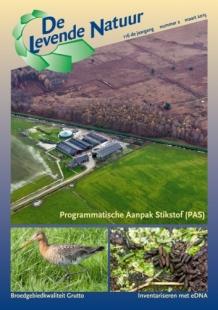De Levende Natuur nummer 2 van 2015 (English summary)
Afbeelding

Integrated Approach to Nitrogen: exploration of the effectiveness and efficiency of measures
D.C.J. van der Hoek, R.J.M. Folkert & R.C.M. Arnouts
The Integrated Approach to Nitrogen (PAS) is expected to boost the restoration of nitrogen-sensitive nature, while also stimulating commercial activities in nearby areas. However, in light of the uncertainties around the implementation of the PAS programme, there is a realistic possibility that nature recovery will not take place in certain areas. Temporary recovery management and hydrological measures are most effective and efficient as recovery measures under the PAS. The temporary character of such recovery management, however, has the obvious drawback of having a limited timespan. The positive effect thus is only temporary and when this measure is applied on a regular basis it may cause the negative side effects to dominate. The compensative contribution of hydrological measures is only limited and these measures are unable to fully solve the problem of eutrophication. This means that source measures will be needed to achieve a sustainable solution to this issue.
Black-tailed Godwits avoid traffic-intense roads less in high quality breeding habitat
A.C. Fikenscher, J.C.E.W. Hooijmeijer, R. Kentie & T. Piersma
To stop the population decline of Black-tailed Godwits (Limosa limosa), high quality breeding habitat needs to be created. To determine where to create such fields it is important to understand if and how disturbance by roads and traffic affects the settlement of breeding Godwits. To investigate the effects of roads, we investigated the distribution and distance of nests relative to different types of roads and compared those between modern grassland monocultures of low breeding quality and herb-rich, wet meadows of high breeding quality. In grassland monocultures, the number of nests found was smaller near roads with higher traffic intensity. Yet the distance between the nests and the roads did not increase with traffic intensity. This is in contrast with other reports in the literature. The nest distribution on herb-rich meadows was less straightforward: due to the high number of nests in de Workumerwaard area, a bias arose towards roads with small traffic intensity. Still, relatively more nests were found near roads with higher traffic intensities in meadows than in monoculture grasslands. This could indicate that the settlement decision of godwits breeding in high quality area is less affected by the traffic intensity of the nearby road. However, the average distance between nests and roads was higher in meadows than in grassland monocultures, indicating that creation of new breeding habitat near busy roads is sub-optimal.
To stop the population decline of Black-tailed Godwits (Limosa limosa), high quality breeding habitat needs to be created. To determine where to create such fields it is important to understand if and how disturbance by roads and traffic affects the settlement of breeding Godwits. To investigate the effects of roads, we investigated the distribution and distance of nests relative to different types of roads and compared those between modern grassland monocultures of low breeding quality and herb-rich, wet meadows of high breeding quality. In grassland monocultures, the number of nests found was smaller near roads with higher traffic intensity. Yet the distance between the nests and the roads did not increase with traffic intensity. This is in contrast with other reports in the literature. The nest distribution on herb-rich meadows was less straightforward: due to the high number of nests in de Workumerwaard area, a bias arose towards roads with small traffic intensity. Still, relatively more nests were found near roads with higher traffic intensities in meadows than in monoculture grasslands. This could indicate that the settlement decision of godwits breeding in high quality area is less affected by the traffic intensity of the nearby road. However, the average distance between nests and roads was higher in meadows than in grassland monocultures, indicating that creation of new breeding habitat near busy roads is sub-optimal.
Shallow inundation for more meadow birds
S.M. Weterings-Schonck & E.B. Oosterveld
In 2012 the farmers' association of the ‘Noordelijke Friese Wouden’ (NFW) managed 8.681 hectares of meadow bird farm land, in 20 areas with mosaic management. In 2012, a total of 5.048 breeding pairs of all meadow bird species were counted, with densities of 11.8 pairs of Black-tailed Godwit, 24.4 pairs of Lapwing, 12.2 pairs of Oystercatcher and 9.6 pairs of Redshank per 100 ha. Total numbers of Godwits, Lapwings, Oystercatchers and Redshanks showed a 19% decline over 2009-2012. In contrast to the overall decline, 6 areas showed an increase in numbers. We studied the role of shallow inundated fields in this population change. Out of 11 factors, the factor that explained population change best, was the percentage shallow inundated fields during the breeding period. The higher the percentage of shallow inundation, the more positive was the population change for these 4 species. In a smart spatial arrangement with other evidence based measures on farm land, shallow inundation may preserve viable meadow bird populations, preferably in areas already containing meadow bird breeding clusters. A case study illustrates the power of shallow inundation for population increase and sufficient reproduction.

